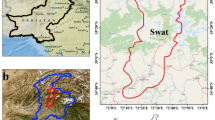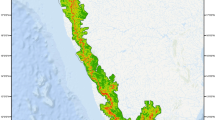Abstract
Natural, as well as human-induced, landscape changes may have profound effects on soil-loss rates in Mediterranean countries. Knowledge of the spatial and temporal distribution of the erosion processes from 1984 to 2013 across the fire-prone island of Thassos was gained on the basis of a joint analysis of imagery received from three generations of Landsat satellites. Soil loss was modeled using the revised universal soil loss equation. With the exception of the crop management factor, which was estimated through the NDVI image series, rainfall erosivity, soil erodibility, and topographic factor, were compiled within a GIS environment and used for the production of the spatio-temporal erosion maps. We found some constant patterns regarding the spatial distribution of soil susceptibility to erosion, similar to the findings of plot scale studies in the Mediterranean, as well as major changes related to the temporal intensity of the process. With regard to the aspect, we found that the most erosion-prone areas diachronically were the south-facing slopes. The highest altitudinal zone was most at soil-loss risk, but this elevation zone occupies the smallest spatial extent compared to the others. We observed a major increase for all the elevation and aspect zones, as well for every watershed of the island, during 1984–1991, when Thassos experienced some catastrophic fires. Between 1984 and 2013, all but one the watersheds of the island experienced a severe increase in soil erosion, suggesting the need for prevention measures and restoration plans that specifically target the areas most vulnerable to degradation. Quantification of the soil loss over large areas and large time extents, can contribute to an understanding of the process, highlight drivers of change and assist in the implementation of erosion control measures and decision making.



Similar content being viewed by others
References
Alexakis DD, Hadjimitsis DG, Agapiou A (2013) Integrated use of remote sensing, GIS and precipitation data for the assessment of soil erosion rate in the catchment area of “Yialias” in Cyprus. Atmos Res 131:108–124
Alexandridis TK, Sotiropoulou AM, Bilas G, Karapetsas N, Silleos NG (2013) The effects of seasonality in estimating the c-factor of soil erosion studies. Land Degrad Dev. In press
Bajocco S, Salvati L, Ricotta C (2011) Land degradation versus fire: a spiral process? Prog Phys Geogr 35(1):3–18
Butt M, Waqas A, Mahmood R (2010) The combined effect of vegetation and soil erosion in the water resource management. Water Resour Manag 24(13):3701–3714
Cerdà A, Lavee H, Romero-Díaz A, Hooke J, Montanarella L (2010) Preface. Land Degrad Dev 21(2):71–74
Chavez PS Jr (1996) Image-based atmospheric corrections - Revisited and improved. Photogramm Eng Remote Sens 62(9):1025–1036
Chou WC (2010) Modelling watershed scale soil loss prediction and sediment yield estimation. Water Resour Manag 24(10):2075–2090
Notario del Pino JS, Ruiz-Gallardo J-R (2014) Modelling post-fire soil erosion hazard using ordinal logistic regression: a case study in South-eastern Spain. Geomorphology: in press
Đukić V, Radić Z (2014) GIS based estimation of sediment discharge and areas of soil erosion and deposition for the torrential Lukovska River catchment in Serbia. Water Resour Manag 28(13):4567–4581
Flabouris K (2008) Study of rainfall factor R on the RUSLE law. PhD thesis. Faculty of Engineering, School of Civil Engineering. Aristotle University of Thessaloniki, Thessaloniki
Gitas IZ, Devereux BJ (2006) The role of topographic correction in mapping recently burned Mediterranean forest areas from LANDSAT TM images. Int J Remote Sens 27(1):41–54
Hijmans RJ, Cameron SE, Parra JL, Jones PG, Jarvis A (2005) Very high resolution interpolated climate surfaces for global land areas. Int J Climatol 25(15):1965–1978
Jaiswal RK, Ghosh NC, Lohani AK, Thomas T (2015) Fuzzy AHP based multi crteria decision support for watershed prioritization. Water Resour Manag 29(12):4205–4227
Kaltsas AM, Mamolos AP, Tsatsarelis CA, Nanos GD, Kalburtji KL (2007) Energy budget in organic and conventional olive groves. Agric Ecosyst Environ 122(2):243–251
Karydas C, Petriolis M, Manakos I (2013) Evaluating alternative methods of soil erodibility mapping in the Mediterranean Island of Crete. Agriculture 3(3):362–380
Kouli M, Soupios P, Vallianatos F (2009) Soil erosion prediction using the Revised Universal Soil Loss Equation (RUSLE) in a GIS framework, Chania, Northwestern Crete. Greece Environ Geol 57(3):483–497
Kumar S, Mishra A (2015) Critical erosion area identification based on hydrological response unit level for effective sedimentation control in a River Basin. Water Resour Manag 29(6):1749–1765
Kumar A, Devi M, Deshmukh B (2014) Integrated remote sensing and geographic information system based RUSLE modelling for estimation of soil loss in western Himalaya. India Water Resour Manag 28(10):3307–3317
Liu Y, Yang W, Yu Z, Lung I, Gharabaghi B (2015) Estimating sediment yield from upland and channel erosion at a watershed scale using SWAT. Water Resour Manag 29(5):1399–1412
Lu D, Batistella M, Mausel P, Moran E (2007) Mapping and monitoring land degradation risks in the Western Brazilian Amazon using multitemporal Landsat TM/ETM+ images. Land Degrad Dev 18(1):41–54
Mallinis G, Maris F, Kalinderis I, Koutsias N (2009) Assessment of post-fire soil erosion risk in fire-affected watersheds using remote sensing and GIS. GISci and Remote Sens 46(4):388–410
Merritt WS, Letcher RA, Jakeman AJ (2003) A review of erosion and sediment transport models. Environ Model Softw 18(8–9):761–799
Miller JD, Nyhan JW, Yool SR (2003) Modeling potential erosion due to the Cerro Grande Fire with a GIS-based implementation of the Revised Universal Soil Loss Equation. Int J Wildland Fire 12(1):85–100
Morgan RPC (2005) Soil erosion and conservation. Oxford: Blackwell Pub, Malden
Morschel J, Fox DM, Bruno JF (2004) Limiting sediment deposition on roadways: topographic controls on vulnerable roads and cost analysis of planting grass buffer strips. Environ Sci Pol 7(1):39–45
Mouflis GD, Gitas IZ, Iliadou S, Mitri GH (2008) Assessment of the visual impact of marble quarry expansion (1984–2000) on the landscape of Thassos island, NE Greece. Landsc Urban Plann 86(1):92–102
Nakos G (1979) General soil map of Greece
Paolini L, Grings F, Sobrino JA, Jiménez Muñoz JC, Karszenbaum H (2006) Radiometric correction effects in Landsat multi‐date/multi‐sensor change detection studies. Int J Remote Sens 27(4):685–704
Renard KG, Foster GR, Weesies GA, McCool DK, Yoder DC (1997) Predicting soil erosion by water: a guide to conservation planning with the Revised Universal Soil Loss Equation (RUSLE). Agric Hanbook 703
Schroeder TA, Cohen WB, Song C, Canty MJ, Yang Z (2006) Radiometric correction of multi-temporal Landsat data for characterization of early successional forest patterns in western Oregon. Remote Sens Environ 103(1):16–26
Shakesby RA, Doerr SH (2006) Wildfire as a hydrological and geomorphological agent. Earth-Sci Rev 74(3–4):269–307
Simms É, Ward H (2013) Multisensor NDVI-based monitoring of the tundra-taiga interface (Mealy Mountains, Labrador, Canada). Remote Sens 5(3):1066–1090
Siyuan W, Jingshi L, Cunjian Y (2007) Temporal change in the landscape erosion pattern in the Yellow River Basin, China. Int J Geogr Inf Sci 21(10):1077–1092
Steven MD, Malthus TJ, Baret F, Xu H, Chopping MJ (2003) Intercalibration of vegetation indices from different sensor systems. Remote Sens Environ 88(4):412–422
Tamene L, Le Q, Vlek PG (2014) A landscape planning and management tool for land and water resources management: an example application in northern Ethiopia. Water Resour Manag 28(2):407–424
Tucker CJ (1979) Red and photographic infrared linear combinations for monitoring vegetation. Remote Sens Environ 8(2):127–150
Van der Knijff JM, Jones RJA, Montanarella L (1999) Soil erosion risk assessment in Italy. In Luxembourg, p 52
Vrieling A (2006) Satellite remote sensing for water erosion assessment: a review. Catena 65(1):2–18
Wang L, Huang J, Du Y, Hu Y, Han P (2013) Dynamic assessment of soil erosion risk using landsat TM and HJ satellite data in Danjiangkou Reservoir Area, China. Remote Sens 5(8):3826–3848
Wischmeier WH, Smith DD (1978) Predicting rainfall erosion losses. In: Agricultural handbook. Wischmeier WH, Smith DD. 1978. Predicting rainfall erosion losses, agricultural handbook 537. USDA Scientific and Educational Administration: Washington
Wittenberg L, Inbar M (2009) The role of fire disturbance on runoff and erosion processes - a long-term approach, Mt. Carmel case study, Israel. Geogr Res 47(1):46–56
Wittenberg L, Malkinson D, Barzilai R (2014) The differential response of surface runoff and sediment loss to wildfire events. Catena 121:241–247
Wondzell SM (2001) The influence of Forest Health and Protection treatments on erosion and stream sedimentation in forested watersheds of eastern Oregon and Washington. Northwest Sci 75(SPEC. ISS):128–140
Zhao H, Chen X, Zhang J, Yin Z (2012) Land-use/-cover change spatial patterns and their impacts on sediment charge in the Longchuan River catchment, south-western China. Int J Remote Sens 33(14):4527–4552
Acknowledgments
Landsat TM, ETM+ and OLI data used were available at no-cost from the US Geological Survey. We would like to thank the Associate Editor and the 2 anonymous reviewers whose insightful comments helped to substantially improve this manuscript.
Author information
Authors and Affiliations
Corresponding author
Ethics declarations
The manuscript has not been submitted to more than one journal for simultaneous consideration. The manuscript has not been published previously (partly or in full), unless the new work concerns an expansion of previous work. This study is not split up into several parts to increase the quantity of submissions and submitted to various journals or to one journal over time.
No data have been fabricated or manipulated (including images) to support the conclusions. No data, text, or theories by others are presented as if they were the author’s own. Proper acknowledgements to other works is given, quotation marks are used for verbatim copying of material, and permissions are secured for material that is copyrighted.
Consent to submit has been received explicitly from all co-authors, as well as from the responsible authorities - tacitly or explicitly - at the institute/organization where the work has been carried out, before the work is submitted.
Authors whose names appear on the submission have contributed sufficiently to the scientific work and therefore share collective responsibility and accountability for the results. The authors do not disclosure of potential conflicts of interest and the research does not involves Human Participants and/or Animals
Additional information
Highlights
• This study presents spatial and temporal changes of soil loss in a Mediterranean fire prone landscape and its linkages with wildfire impacts and human-induced disturbances.
• Due to their subtle differences, vegetation indices derived from different Landsat satellites were used complementary for the temporal study of the phenomenon. following correction of atmospheric and cross-sensor inconsistencies.
• The soil loss is more evident in south facing slopes and steep gradients similar to the findings of plot-scale studies in Mediterranean areas.
Rights and permissions
About this article
Cite this article
Mallinis, G., Gitas, I.Z., Tasionas, G. et al. Multitemporal Monitoring of Land Degradation Risk Due to Soil Loss in a Fire-Prone Mediterranean Landscape Using Multi-decadal Landsat Imagery. Water Resour Manage 30, 1255–1269 (2016). https://doi.org/10.1007/s11269-016-1224-y
Received:
Accepted:
Published:
Issue Date:
DOI: https://doi.org/10.1007/s11269-016-1224-y




